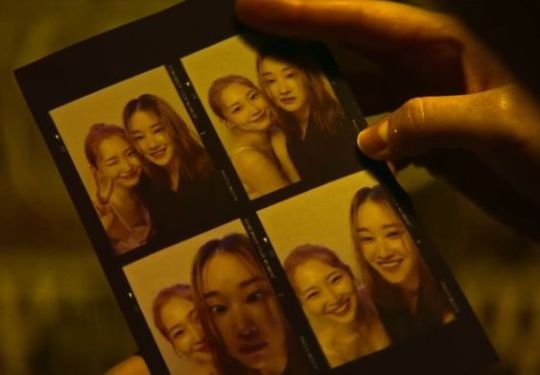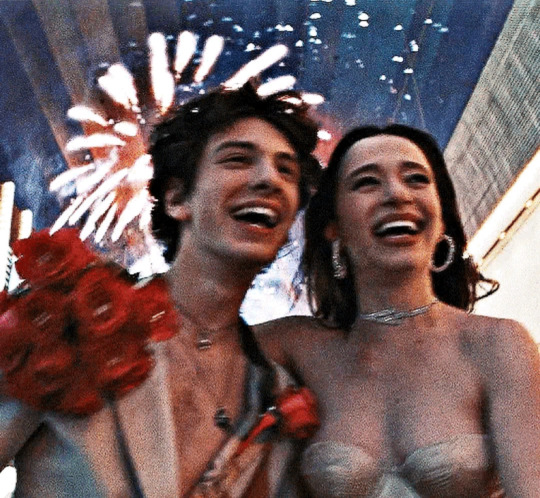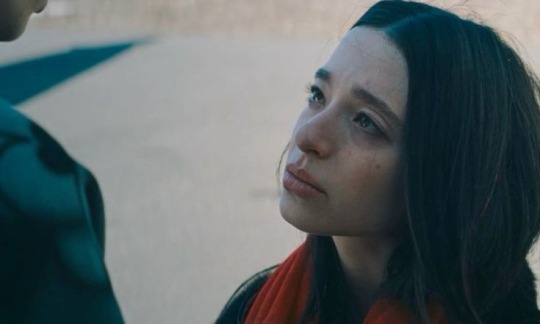#filmanalysis
Explore tagged Tumblr posts
Text

Anora experiences for the first time a relationship that is not transactional and someone genuine. Thus, the breakdown is a sign of comfortability as she feels she can show her genuine self in front of someone who isn't expecting her to act as the sexualised object she's been throughout her entire career.
- one reddit user's interpretation
#anora#anora movie#film#mikey madison#movie review#anora film#movies#film analysis#filmanalysis#movie thoughts#movie discussion#cinema#thoughts
136 notes
·
View notes
Text
A Love That Lingers in the Air: Revisiting Call Me by Your Name
Some films do not just tell a story but instead capture a feeling, a place, a time that exists somewhere between memory and dream. To me, Call Me by Your Name is one of those films, an experience more than a narrative, a meditation more than a story. Watching it feels like slipping into a sun-drenched afternoon, where time is slow, the air is thick with the scent of peaches, and love unfurls gently like a lazy river winding its way through the Italian countryside.
The film, directed with exquisite tenderness by Luca Guadagnino, is not in a hurry. It breathes. It listens. It watches. The cinematography by Sayombhu Mukdeeprom captures light with an almost painterly quality, bathing everything in warm, golden hues that feel like an eternal summer. The quietness of the set, the careful use of natural sound—the rustling of leaves, the crunch of a bicycle on gravel, the distant laughter of a family at dinner, and the cicadas humming in the heat, create an intimacy so immersive that we don’t just watch Elio and Oliver fall in love, we feel it.
There is no obvious antagonist, no grand external conflict. The greatest tension in Call Me by Your Name is not between the characters but within them, the quiet ache of longing, the tentative steps toward something beautiful and terrifying all at once. This is a world without cruelty, without villains. It is a place where love is allowed to bloom without resistance, where a father speaks words of kindness and understanding rather than condemnation, and where heartbreak is met not with destruction but with reflection. It is, in many ways, a utopia -- not in the sense that it is perfect, but in the way that it holds space for love in its purest, most fragile form.
Timothée Chalamet delivers a performance that feels so unguarded, so honest, that it is as though we are watching a heartbeat in real-time. His Elio is raw and intellectual, self-assured yet impossibly vulnerable. Armie Hammer’s Oliver, in contrast, is golden and enigmatic, carrying the kind of effortless confidence that only makes his moments of hesitation all the more devastating. Their chemistry is electric but also tender; it simmers beneath the surface, in glances and gestures, in the space between words.
And then there is the silence. The spaces between dialogue, the room tone that lingers after a moment of connection—Guadagnino understands that love is not just in what is said but in what is left unsaid, in what is felt in the pauses, in the weight of a glance, in the way a hand hovers before it dares touch.
Call Me by Your Name is not just a love story; it's a memory preserved in amber, a summer that never quite ends, a song played softly in the background of one’s life long after it has faded. It's the ache of first love, the bittersweet beauty of something fleeting, the quiet devastation of knowing that some things, no matter how perfect—are not meant to last. And yet, even in that impermanence, it lingers. It remains. Like the echoes of laughter on a warm evening, like the last notes of a song before silence takes over. Like the rustling of trees long after the lovers have gone.
~ E. V. Carlson
Video credit: Editsect on YT
#CallMeByYourName#CMBYN#LucaGuadagnino#TimothéeChalamet#ArmieHammer#ElioPerlman#Oliver#ItalianSummer#QueerCinema#LGBTQFilm#FirstLove#ComingOfAge#Cinematography#FilmAesthetic#MovieMagic#IndieFilm#FilmAnalysis#PoeticCinema#NatureSounds#LoveAndLonging#BittersweetRomance#SunDrenchedCinema#SoftFilmmaking#SummerFeels#MemoryInFilm#HeartfeltCinema#love#hopecore#hope#poetry
49 notes
·
View notes
Text
🦇 Nosferatu (2024): A Psychological & Sociological Deep Dive 🦇
📽 New Video Analysis! Robert Eggers’ Nosferatu (2024) is a haunting reimagining of the silent horror classic, blending psychological depth, sociological themes, and stunning cinematic artistry.
But beyond the gothic horror and eerie visuals, Nosferatu taps into something deeper—our collective fears, historical anxieties, and the way society pathologizes human emotions.
🔗 Watch the Full Video Here: 👇
youtube
🔎 Key Themes Explored in the Video: 💀 Melancholy & Hysteria – How Ellen’s diagnosis mirrors historical attitudes toward women’s emotions. 🧠 Depression & Histrionic Personality Disorder – How these 19th-century labels evolved into modern psychology. 🦠 Xenophobia, Disease & the Fear of the "Other" – How Nosferatu reflects societal anxieties from Bram Stoker’s Dracula to today.
💬 What do you think? Is Nosferatu purely a horror story, or does it hold a mirror to our deepest fears? Drop your thoughts below! ⬇️
#psychology#psychology in film#nosferatu#sociology#Youtube#nosferatu 2024#robert eggers#horror#horror movies#horror films#vampire#gothic#movie review#nosferatu movie#FilmAnalysis#PsychologyInFilm#GothicHorror#HorrorMovies#MovieReview#Dracula#MentalHealth#sociology in film
44 notes
·
View notes
Text
Film- and Timelineanalysis Resident Evil: Damnation
It happened to me too getting confused, so I am going to tell you, when Resident Evil: Damnation actually plays and how we (Instagram: @Recos_Coop) found it out!
In the beginning of the movie, Sasha, the Detagonist of this movie told, that the rumors about the use of B.O.Ws in the ESR, ended February 2011 in Holigrad. A few kilometers away from the presidentials' palace.
I thought, Damnation takes place February 2011. Until a few months ago! (More below! 👇)

On this image we have a great look onto some documents, Ada had brought with to give a presentation to the president of the ESR, Svetlana Belikova, and some other good marked commands. There are several topics listed on, alike photos, of spotted Lickers and Cerberus', taken on the ESR battlefield. A Plaga. And footages from the Havard Ville Incident (CGI Movie: Resident Evil: Degeneration).
If you take a look very closely, you are able to read the data, on which date, Ada has written the paper.

These are been written on 31st, October 2011.
Which means, the events in the CGI Movie Resident Evil: Damnation, takes place in November 2011! (Between the 1st, November until the following week.)
It also means, that the Guerillas, fought against the military over half a year long in a small town like Holigrad.
In my eyes it is indeed very impressive! Ataman and his fellow men (including Sasha and JD) were very strong and tactically still intact. Even tho, they sometimes had their trouble with the B.O.W's, they had carried around with.
I also think, that Sasha was the only hope to the Guerillas, since he was the only one after Ataman, being strong and willed enough, to inject himself with the Plaga.
For a promised new tomorrow.

Want to know more about little details about this movie? What do you think of it? Just tell me~!
#resident evil#residentevil damnation#re damnation#alexander sasha kozachenko#ada wong#ataman#leon s kennedy#filmanalysis#timeline#resident evil damnation#JD#capcom#data
11 notes
·
View notes
Text
Ballerina: A Cinematic Recital of Revenge

Ballerina, an action-packed film, takes a unique approach to the revenge genre by incorporating ballet elements into its narrative. The story kicks off with Okju, who appears to be on leave from a high-end security firm, thwarting a robbery with canned vegetables. However, her life takes a dark turn when her friend Min-hee, known as "Ballerina," commits suicide and leaves a note asking for vengeance. Director Lee Chung-hyun, known for his previous work on The Call, creates Ballerina, a cinematic masterpiece (at least to me) that serves as the platform for a revenge story. Determined to convey a sense of recital or performance art, Lee successfully emphasized factors such as cinematography, production design, and music, to the point where the title tracks directed by GRAY were titled after ballet terms such as "Adagio" or "Coda" aligning with the film's theme. A standout feature is the virtual spaces designed for the main characters—Okju, Min-hee, and Choi (the antagonist). The art director Kim Min-hye utilized symbolic elements to convey emotions, such as warmth in Okju's lonely house, fragility in Min hee's space decorated with a fish tank, and humility in Choi's house adorned with antique pieces and artworks. Ballerina addresses dark themes of assault, grooming, and human trafficking, highlighting a woman's fight for justice. The film relies on striking visuals and cinematography, using fluorescent lights and vibrant colors in flashback scenes to contrast the harshness of the overall story. Okju's character development and strength lead to a satisfying ending, with the villain meeting a painful demise at her hands.
20 notes
·
View notes
Text

War, Fear, and a Dying World: The Terrifying Relevance of Children of Men
This week, we dive into a very different — but no less brutal — vision of dystopia. Children of Men imagines a future where no child has been born in over 18 years, and humanity faces extinction. As society collapses into chaos, Britain clings to authoritarian control, becoming one of the last functioning nations under totalitarian rule.
Full episode drops Thursday AEST.
#ChildrenOfMen#Dystopia#DystopianFuture#DystopianPodcast#SciFiPodcast#AlfonsoCuaron#TheoFaron#CliveOwen#PodcastTeaser#PodcastRecommendations#FilmAnalysis#DarkFutures#Totalitarianism#InfertilityCrisis#EndOfHumanity#BleakCinema#CinematicDystopia#WarAndFear#PodcastPromo
1 note
·
View note
Text
Murder on the Dancefloor: The Chokehold of Oliver Quick
'Saltburn' has catapulted leading actor Barry Keoghan into our daydreams, revitalised music careers stagnant since 2007, and ensured we never look at a bathtub the same way ever again. It's delicious darkness has amassed a huge audience, some revelling in its lurid glory and others questioning what the f*** they just watched. There’s so much to say about this film, so many parallels and Easter eggs that tickle the brain notice - for today, I’m focusing on why Oliver Quick intrigued me the most.
As a devoted horror fan, some of the more controversial scenes served to stimulate rather than disturb… The vampire scene? That's just an average Tuesday night for some. The grave scene? Nothing compared to the visual impact Patrick Bateman’s hobbies. But what did succeed to unnerve me was the turning point of the film, when Felix suprised Oliver with a trip home for his birthday. You watch with stunned panic as she says his dad has been pacing all day waiting for him - in real time the web was unravelled and Oliver's traumatic background was quickly proven to be a façade. For me this scene positioned the 'real' Oliver to the audience, realising the person we thought we knew isn’t real at the same time his friend does. And this is where my interest peaked. For me, this film suddenly turned from a critique of the upper class, to a mythological study of a sociopath, and the subsequent events demonstrate how someone with an apathetic disposition could easily infiltrate and dominate a household of such wealth and status.
On a second watch, I couldn't help but laugh at Felix's naiveity as he pulled into the driveway of this enormous house, and noted that it looked as though his mother 'had really turned things around'. Anyone watching this would immediately question how someone allegedly suffering with severe mental illness and drug abuse issues manages to, in the space of less than 6 months, become the owner of a property of that scale. This small observation highlights just how out of touch Felix is anyone outside of his social class, and how Felix's pity towards Oliver, be it through kindness or ego or a convenient blend of the two, blinded him to the manipulation.
Another incredibly successful aspect of the film is the iconic soundtrack. It has brought some early 2000 musical classics back into the spotlight (we all know the best one) and I can admit I have listened to 'Loneliness' more times in the past two weeks than ever in my 26 years of life. The soubdtrack embodies the nostalgic and romanticised qualities of the film, set in 2006 before smartphones dictated every aspect of daily life, especially as a fresher. I may have been only 10 when Oliver Quick started university, it still made me long for the simplicity of this era of my life, when getting to know another person was fundamentally down to face to face interaction.
The choice to turn back time to the mid 2000s contributes to maintaining the mystery of Oliver's identity, depriving the characters of the ability stalk his social media profiles and forcing them to take his personality at face value. His manipulation, and eventual dismantling of the Catton family, was arguably possible through his ability to present himself without the hinderance of a digital footprint. There was no evidence available to anyone in Oliver's immediate circle of the sisters we found out he had, of the father that had infact not died, nor been an alcoholic drug dealer. So why did he lie?
In analysis I've seen online, many people contribute his deception to a need to be noticed by Felix, or in Oliver's own words, to 'perform' for his attention and friendship.
Revisiting the film, I picked up on certain phrases Oliver used to describe his home life, describing it as 'dirty' and proclaiming he could 'never go back'. To us, this sounds like the way you would describe his chaotic home life he described. But when the reveal comes, you can’t help but question why he’s adamant to distance himself from a seemingly stable, and privileged background.
During the scene, his parents also mention how he is the top scholar at Oxford, a member of the rowing team, participating in the school play... his chronic deception extends beyond the Catton family to his own. They also share with Felix that he was 'such a loner' and was 'so clever' that he struggled to make friends, both earmark characteristics of someone with sociopathic tendencies. This illustrates an individual who has never been satisfied, who always saw himself as superior, and who's fixation with Felix was just a desire to climb up and out of all the menial and average and into a position of absolute control.
The grandiose and self-absorbed lifestyle of the Saltburn estate allowed for someone like Oliver, whatever his original or developed intentions, to blend in without being truly seen until, both before and after death came knocking. The need to stifle emotional expression (We don't want to hear your American feelings, Farleigh!) and the uncomfortable obligation to uphold the British sentiment to 'Keep Calm and Carry On' gave him an invisibility cloak, blending in with his surroundings. It reframed Oliver's awkward disposition as one of politeness, and his manipulative sexual deviancy was guarded by members of the household behind a wall of upper class social etiquette.
I can safely say I have fallen into the deliciously depraved world of Saltburn, so much so I’ve felt like I had to write this. I love experiencing and analysing media, but this one really had me captivated. This is a maze will happily lose myself for weeks to come, especially when it comes to the complex and captivating portrayal of Oliver Quick - I would definetly sign my estate over to that beautiful crazy bastard.
#artbychelcie#saltburn#oliverquick#barry keoghan#emeraldfennel#saltburnmovie#goldenglobes#sociopath#filmanalysis
13 notes
·
View notes
Text
"We are lost in our freedom, longing to feel urgency, necessity, the preciousness of time in love and in like, the irrevocableness of a decision; but when anything is possible, nothing is special." -Molly Haskell
#mollyhaskell#quotes#literature#film#filmanalysis#womeninfilm#freequotes#blackwriters#blackwritersontumblr#library
5 notes
·
View notes
Text
Movie Analysis and Review: "Keeping Up with the Joneses" (2016)
Synopsis:“The Gaffneys’ lives take an unexpected turn when new neighbors, Tim and Natalie Jones, inject glamour and mystery into their mundane suburban existence. As the couple becomes entangled in international espionage, their ordinary lives give way to a thrilling adventure beyond the confines of their cul-de-sac.” Key Themes:“Keeping Up with the Joneses” revisits the classic Touchstone…

View On WordPress
#AndrewWilliamDunn#CinematicAnalysis#Cinematography#ComedyFilm#Espionage#Farid M. H. Sadeqi#Farid Sadeqi#FilmAnalysis#GalGadot#GregMottola#Hosein Tolisso#IslaFisher#JonHamm#KeepingUpWithTheJoneses#MichaelLeSieur#Mohammad Hosein Sadeqi#MovieCritique#MovieOpinion#MovieReview#SoundtrackReview#SpyComedy#SuburbanAdventure#SuburbanLife#TouchstonePictures#ZachGalifianakis
1 note
·
View note
Text
Returning to a Familiar Place of Love: 500 Days of Summer and Meri Pyaari Bindu
Do you have that one place in your home or your city with which a lot of memories are attached? Memories concerning a person or an experience which you will carry with you for the rest of your life? Meri Pyaari Bindu and 500 Days of Summer share narrative affinities and spotlight is given to that one place where love blossoms as well as withers. In Meri Pyaari Bindu, Bindu and Abhi’s favourite…
View On WordPress
3 notes
·
View notes
Text
youtube
Jurassic Park warned us not to play God, but Jurassic World missed the memo. Do you agree or disagree? Tell us about it!
#JurassicPark#JurassicWorld#MovieReview#FilmAnalysis#DinosaurMovies#Spielberg#MovieLore#FranchiseFail#NatureVsMan#MythsAndMischief#Youtube
0 notes
Text


Ivan saw Anora as a fleeting distraction - someone to fill the time before he returned home, a tool to provoke his mother, and ultimately, someone disposable. He wanted her, but he never loved her. And so, Anora’s tragedy isn’t just about losing Ivan, but also realising what she thought was real was never real at all.
#anora#anora movie#film#mikey madison#movie review#anora film#movies#filmanalysis#movie thoughts#film analysis#tragic#tragic love#unrequited love#heartbreak
17 notes
·
View notes
Text
Mickey 17 and Why Setting the Stakes Early Is Everything 🎬💀

If you’ve ever watched a movie and thought, “Why should I even care about these characters?” — it probably failed to establish the stakes.
Our latest Mixed Reviews blog post breaks down why stakes matter, using Bong Joon-ho’s upcoming sci-fi mind-bender Mickey 17 as a textbook example.
💥 In the first 20 minutes:
Mickey is dehumanized.
Forced into trauma loops.
Treated as disposable in a system that values utility over life.
This isn’t just sci-fi — it’s social horror. It’s commentary on labor, legal systems, and the erosion of human dignity.
✨ Read the full breakdown and learn why this film might be one of the boldest existential sci-fi statements of the decade. 🔗 Mickey 17 & The Importance of Establishing The Stakes
#Mickey17#RobertPattinson#BongJoonHo#SciFiCinema#FilmAnalysis#MixedReviews#StakesMatter#NarrativeDesign#MovieNerds#CinemaDiscourse#StorytellingTips
1 note
·
View note
Text
Film Studies Students! This is the perfect Notebook for YOU.

I ❤️ Love Film Studies NOTEBOOK!

(As an Amazon Associate, I earn from qualifying purchases.)
0 notes
Text
In a surprising announcement, former President Donald Trump has revealed an audacious plan to transform Gaza into a luxurious tourist hotspot by 2025, leveraging his real estate empire. The proposal includes building opulent hotels, golf courses, and beachfront resorts, with towering skyscrapers embellished in his iconic gold accents. This initiative aims to boost the local economy and create jobs, sparking heated debates about its potential impact. While supporters see it as a beacon of investment and stability, critics argue it neglects the region's deep-seated political and humanitarian complexities. As the world watches closely, will Trump's luxury-focused vision for Gaza pave the way for peace or lead to further discord in this troubled area? Trump's Bold Vision: Transforming Gaza into a Luxury Oasis by 2025? published first on https://www.youtube.com/@DeepReels2025/
#DeepReels2025#MovieReviews#FilmAnalysis#Storytelling#CinemaLovers#MovieBreakdowns#VisualStorytelling#BehindTheScenes#HiddenGems#CinematicArt
0 notes
Text

“Even if they discovered the cure for infertility, doesn’t matter. Too late. World went to shit. Know what? It was too late before the infertility thing happened — for fuck’s sake.” — Theo, Children of Men
Before the bombs, before the cages, before the last birth — the world was already broken. In Children of Men, infertility isn’t the cause of collapse. It’s the result of a society that has lost all hope.
Does humanity deserve to go on — or have we outstayed our welcome?
New episode drops Thursday AEST.
#ChildrenOfMen#TheoFaron#Dystopia#DystopianQuotes#PodcastTeaser#SciFiFilm#AlfonsoCuaron#EndOfTheWorld#BleakFutures#InfertilityCrisis#NoFuture#PodcastBuildUp#DystopianCinema#FilmAnalysis#HopeIsDangerous#PodcastPromo#CliveOwen#ApocalypticThemes#DarkFiction#HumanityOnTheEdge
0 notes